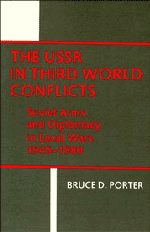Book contents
- Frontmatter
- Contents
- Preface
- 1 Introduction
- 2 The USSR in local conflicts: a historical overview
- 3 Soviet power projection: advances in postwar military capabilities
- 4 The case studies: a framework for analysis
- 5 The Yemeni civil war
- 6 The Nigerian civil war
- 7 The Yom Kippur war
- 8 The Angolan civil war
- 9 The Ogaden war
- 10 Conclusions
- Index
2 - The USSR in local conflicts: a historical overview
Published online by Cambridge University Press: 05 August 2011
- Frontmatter
- Contents
- Preface
- 1 Introduction
- 2 The USSR in local conflicts: a historical overview
- 3 Soviet power projection: advances in postwar military capabilities
- 4 The case studies: a framework for analysis
- 5 The Yemeni civil war
- 6 The Nigerian civil war
- 7 The Yom Kippur war
- 8 The Angolan civil war
- 9 The Ogaden war
- 10 Conclusions
- Index
Summary
In short, the Communists everywhere support every revolutionary movement against the existing social and political order of things.
Karl Marx and Friedrich Engels, The Communist ManifestoBetween 1945 and 1980, well over 100 separate wars took place around the globe, the vast majority of them in or between developing countries. The Soviet Union was involved as a major arms supplier and diplomatic actor in some 20 of these conflicts. Although these figures suggest that the USSR steered clear of local wars far more often than not, involvement in 20 conflicts nevertheless represents an extraordinarily high level of foreign commitment for a country that prior to World War II only rarely had acted as a major supplier of arms, or even as a principal diplomatic actor, in conflicts outside Europe. Furthermore, under the tsars, and during the first two decades of Soviet rule, Russia had generally avoided any kind of involvement in conflicts not on or near its borders, whereas most of the conflicts in which it became involved after 1945 took place in regions of Asia, Africa, and the Middle East that were not contiguous to the Soviet Union.
At least three factors contributed to the USSR's enhanced diplomatic and military roles in local conflicts after 1945. First, and most obvious, was the vast expansion of Soviet military power that took place as a result of the war with Nazi Germany.
- Type
- Chapter
- Information
- The USSR in Third World ConflictsSoviet Arms and Diplomacy in Local Wars 1945–1980, pp. 5 - 35Publisher: Cambridge University PressPrint publication year: 1984



